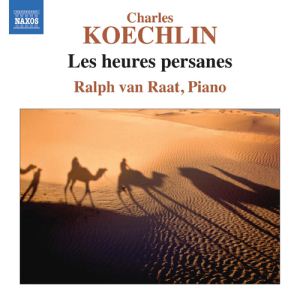 |
 |
|


alternatively
CD: MDT
AmazonUK
AmazonUS
Sound
Samples & Downloads |
Charles KOECHLIN (1867-1950)
Les heures persanes,Op. 65 (1916-1919)
No. 1 Sieste, avant le départ: Lent [3:37]
No. 2 La caravane (rêve, pendant la sieste): Pas vite [5:53]
No. 3 L'escalade obscure: Adagio (non troppo) [1:54]
No. 4 Matin frais, dans la haute vallée: Pas trop lent [2:50]
No. 5 En vue de la ville: Moderato [1:47]
No. 6 A travers les rues: Allegro vivo [4:06]
No. 7 Chant du soir: Très calme [2:06]
No. 8 Clair de lune sur les terrasses: Andante moderato [3:10]
No. 9 Aubade: Moderato [2:22]
No. 10 Roses au soleil de midi: Presque adagio [2:23]
No. 11 A l'ombre, près de la fontaine de marbre: Moderato
[2:24]
No. 12 Arabesques: Allegro (non troppo) [1:46]
No. 13 Les collines, au coucher du soleil: Très calme [2:43]
No. 14 Le conteur: Assez lent - Le pêcheur et le Genni - Le
Palais enchanté - Danse d'adolescents - Claire de lune sur
les jardins [7:27]
No. 15 La paix du soir, au cimetière: Assez lent [6:22]
No. 16 Derviches dans la nuit: Assez animé, nocturne, mysterieux
- Variante - Clair de lune sur la place déserte [5:53]
 Ralph van Raat (piano)
Ralph van Raat (piano)
rec. 11-12 August 2010, Sweelinckzaal, Amsterdam, The Netherlands
 NAXOS 8.572473 [56:43]
NAXOS 8.572473 [56:43]
|
|
|
Charles Koechlin was a fascinating character, whose interest
in astronomy, mythology and foreign travel suggest a mind hungry
for the esoteric and exotic. Regarded as one of his finest works
Les heures persanes (The Persian Hours)is a good
example of his interest in the latter. It’s based on the
French novelist and traveller Pierre Loti’s Vers Ispahan,
detailing his journey across Persia. Koechlin’s hour-long
work is a series of pieces - condensed into just two-and-a-half
days - that captures and distils the scents and sounds of this
faraway land.
Leading this caravan is Dutch pianist Ralph van Raat, whose
account of Rzewski’s The People United Shall Never
Be Defeated! (8.559360) and recently, his partnership with Håkon Austbø
in Messiaen’s Visions de l'Amen (8.572472) impressed
me a great deal. He’s even penned the admirably concise
liner-notes for this new issue, in which he offers thumbnails
of each movement. The first three cover a half-day, the next
five a whole one, and so on. It’s an intense, eventful
trek, but as van Raat’s Messiaen demonstrates he’s
no stranger to the long span.
For those unfamiliar with this music it’s very much of
its time and artistic milieu, with traces of Debussy and Ravel,
not to mention Fauré. The opening siesta is a good indication
of Koechlin’s manner; it’s both direct and sensuous,
a balance well struck in van Raat’s reading of this epic
score. Such writing invites one to dwell - almost narcissistically
- on its rich harmonies, a trap the pianist avoids at all times.
The swaying rhythms of the evening caravan are superbly articulated
and van Raat finds a delicate shimmer in the notes. The warm,
natural recording is a real pleasure too. Each and every detail
of this finely calibrated performance is well caught.
I particularly like the way the end of each movement is allowed
to evaporate, rather like a mirage. The listener is given plenty
of time to relish and reflect on what’s just passed. The
first full day is a kaleidoscope of shifting colours. The dark
sonorities of the piano’s lower registers are beautifully
complemented by a pellucid treble that doesn’t grate or
glare. Just sample the glitter that accompanies the first view
of the town (tr. 5) and the bravura of its bustling streets
(tr. 6). Van Raat is never less than commanding, and his ear
for textures and the almost imperceptible shifts of harmony
- in ‘Chant du soir’ and the moonlit terrace for
instance - is very impressive indeed. It’s not so much
a trembling, evanescent nightscape à la Debussy
as a detailed photograph, rendered in strong outlines and sharp
contrasts.
The second full day (trs. 9-13) has some of Koechlin’s
most attractive music, from that affectionate aubade through
to the glowing hills at sunset. In between, the midday sun beats
down on still-perfumed roses (tr. 10) and our weary traveller
retreats to the play and plash of a marbled fountain (tr. 11).
There’s a pleasing economy of style here. Those elusive
scents and cooling waters are most beautifully evoked - perhaps
etched is the better word. The descent into silence is very
well scaled. Paradoxically this music seems both flamboyant
and subtle, and it’s a mark of van Raat’s skill
that this delicate balance is maintained throughout.
The last three movements are an exotic summation. Tr. 14 blends
Ravelian edge and glitter with Debussian mist and reticence.
It’s another of those sleights of hand that Koechlin does
so well; and it’s not the last either. The cemetery at
night manages to be musically more rigorous yet retains its
open-ended, evocative character. Van Raat has an almost Usher-like
sensitivity to the tiniest sounds, so he’s very fortunate
to have such a detailed and immersive recording. This is the
kind of piano sound I associate more with Hyperion than Naxos.
Indeed, the piano’s gentle tolling at the very end of
the piece has astonishing presence and weight.
As much as I’ve enjoyed van Raat’s previous discs
this one is really rather special. His judgment is impeccable
and the playing is free of artifice or exaggeration. That, coupled
with top-notch sound, makes this a mandatory purchase for all
pianophiles.
Richly rewarding; an ideal gateway to Koechlin’s fascinating
soundscapes.
Dan Morgan
http://twitter.com/mahlerei
[We should also note the existence of other recordings of this
cycle: Margaret Fingerhut on Chandos CHAN9974 (highly thought
of by Michael Cookson) and Herbert Henck on Wergo WER 60137-50. It can
be heard in its orchestral guise on Hänssler CD 93.125
(review) and Marco Polo 8.223504.
Ed.]
|
|

